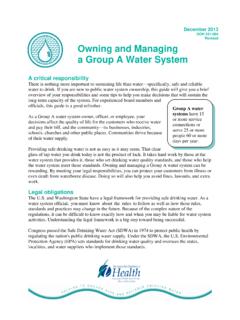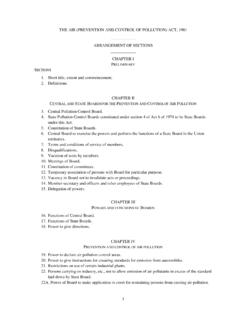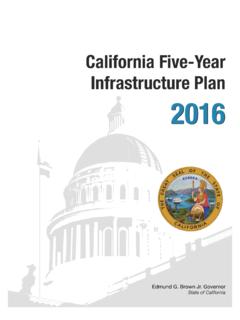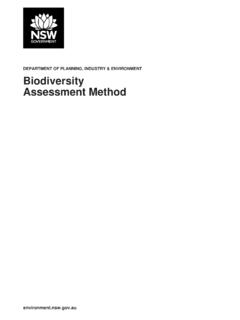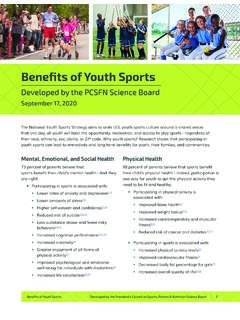Transcription of Visitor Use Management Framework
1 Visitor Use Management FrameworkA Guide to Providing Sustainable Outdoor Recreation Edition One | July 2016 This page intentionally left blank. This publication was prepared by the Interagency Visitor Use Management Council, which consists of the following agencies:DEPARTMENTAGENCYD epartment of the InteriorBureau of Land ManagementNational Park Fish and Wildlife ServiceDepartment of Forest ServiceDepartment of CommerceNational Oceanic and Atmospheric AdministrationDepartment of Army Corps of EngineersiJuly 2016, Edition OneContentsAbstract ..viChapter 1: Introduction ..1 Overview and Purpose ..3 Organization of the Framework ..4 Chapter 2: The Sliding Scale of Analysis ..7 Determination Criteria for Placement on the Sliding Scale ..7 Decision Support Tool ..8 Relating Issues to the Sliding Scale ..10 Summary of the Sliding Scale ..18 Chapter 3: Framework Elements ..21 Element 1: Build the Foundation.
2 23 Step 1. Clarify the Project Purpose and Need ..23 Step 2. Review the Area s Purpose and Applicable Legislation, Agency Policies, and Other Management Direction ..24 Step 3. Assess and Summarize Existing Information and Current Conditions ..25 Step 4. Develop a Project Action of Element 1 ..28 Element 2: Define Visitor Use Management Direction ..29 Step 5. Define Desired Conditions for the Project 6. Define Appropriate Visitor Activities, Facilities, and Services ..34 Step 7. Select Indicators and Establish Thresholds ..38 Summary of Element 2 ..42 Element 3: Identify Management Strategies ..43 Step 8. Compare and Document the Differences between Existing and Desired Conditions, and, for Visitor Use-Related Impacts, Clarify the Specific Links to Visitor Use Characteristics ..44 Step 9. Identify Visitor Use Management Strategies and Actions to Achieve Desired Conditions ..46 Step 10. Where Necessary, Identify Visitor Capacities and Additional Strategies to Manage Use Levels within Capacities.
3 50 Step 11. Develop a Monitoring Strategy ..55 Summary of Element 3 ..57ii Visitor Use Management Framework : A Guide to Providing Sustainable Outdoor Recreation Element 4: Implement, Monitor, Evaluate, and Adjust ..58 Step 12. Implement Management Actions ..59 Step 13. Conduct and Document Ongoing Monitoring, and Evaluate the Effectiveness of Management Actions in Achieving Desired Conditions ..59 Step 14. Adjust Management Actions if Needed to Achieve Desired Conditions, and Document of Element 4 ..62 Chapter 4: Relationship to Larger Agency Planning Processes ..65 Agency Planning Policies and Procedures Specific to the Framework ..65 Relationship to Each Agency s Planning Policies and Procedures ..66 Appendix A: History and Limitations of Previous Visitor Use Management Frameworks ..93 Early Visitor Use Management Concepts and Frameworks ..93 Limitations of Previous Frameworks ..94 Appendix B: Hypothetical Example of the Application of the Visitor Use Management Framework .
4 97 Moose Creek Watershed Restoration Project ..97 Appendix C: Sliding Scale Decision Support Tool ..111 Glossary of Key Terms ..113 References ..115iiiJuly 2016, Edition OneFIGURESF igure 1. Overview of the Visitor Use Management Framework ..4, 21 Figure 2. Elements and steps of the Visitor Use Management Framework ..22 Figure 3. Illustration representing the range of settings included in the Recreation Opportunity Spectrum ..32 Figure 4. Management triggers and thresholds in relation to trend in conditions ..40 Figure 5. Planning process for refuge comprehensive conservation plans ..75 Figure 6. Forest Service Planning Model ..80 Figure 7. Planning model for revision or amendment to a land Management plan ..81 Figure 8. The Recreation Opportunity Spectrum in relation to land Management and USFS project planning ..84iv Visitor Use Management Framework : A Guide to Providing Sustainable Outdoor Recreation TABLEST able 1.
5 Example of a completed decision support tool for determining the location of a project on the sliding scale of analysis: Reduce the size of a campground ..9 Table 2. Example of a completed decision support tool for determining the location of a project on the sliding scale of analysis: Manage overnight use at a popular national park ..12 Table 3. Example of a completed decision support tool for determining the location of a project on the sliding scale of analysis: Decide capacity in a low-use remote river setting ..14 Table 4. Example of a completed decision support tool for determining the location of a project on the sliding scale of analysis: Decide capacity in a high-use river setting ..16 Table 5. Example of a product from steps 5 and 6 a historical park s desired conditions and appropriate activities and facilities for multiple zones ..36 Table 6. Large-scale plans required for federal land- and water-managing agencies.
6 66 Table 7. Policy direction for Visitor use planning and Management on refuge lands and waters ..78 Table 8. The Recreation Opportunity Spectrum class descriptions ..83 Table B1. Decision support tool for the Moose Creek Watershed Restoration Project ..97 Table C1. Blank decision support tool ..111vJuly 2016, Edition OneAbstractVisitor use Management is fundamental for maximizing benefits for visitors while achieving and maintaining desired resource conditions and Visitor experiences on federally managed lands and waters. By using this Visitor Use Management Framework , managers collaboratively develop long-term strategies for providing access, connecting visitors to key Visitor experiences, protecting resources, and managing Visitor use. The purpose of the Framework is to provide cohesive guidance on four major elements for analyzing and managing Visitor use on federally managed lands and waters.
7 It is also intended to provide a legally defensible, transparent decisionmaking process that meets law and policy requirements, ensures agency accountability, and provides sound rationales upon which to base Management decisions and actions. A common thread throughout the Framework is the use of the sliding scale. A sliding scale is used to ensure the investment of time, money, and other resources for a project is commensurate with the complexity of the project and the consequences of the decision. Issues with clearly small impacts usually require less depth and breadth of analysis than those with impacts of greater significance. Overall, this Framework is meant to be adaptable to different agencies policies and regulations and yet allow for a professional, comprehensive, and consistent approach to Visitor use Management on federally managed lands and Visitor Use Management Framework : A Guide to Providing Sustainable Outdoor Recreation Chapter 1: Introduction1 This page intentionally left blank.
8 Chapter 1: Introduction Everybody needs beauty as well as bread, places to play in and pray in, where Nature may heal and cheer and give strength to body and soul alike. - John Muir, 1912 Every year, people across the country flock to federally managed lands and waters for a variety of recreational purposes. Some are visiting an area for the first time, while others are returning to places they visit year after year. Some visitors are alone, and others visit with friends and family. On any given day, visitors are planning their trips, others are immersed in a long visit, and some are heading home and reflecting on their shared memories of time well spent. Recreation is a core element of American culture and a vital thread in the fabric of society. It allows people to connect with their natural and cultural heritage, be healthier in mind and body, enhance the bonds between family and friends, contribute to the economic vitality of communities, and be inspired and rejuvenated.
9 Further, these opportunities allow people to better understand and care for resources and federal lands and waters, creating citizen stewards who want to support sustained Management of our collective last decade has been an exciting time with many initiatives, such as the White House s America s Great Outdoors and Every Kid in a Park and the Department of the Interior s America s Youth in the Great Outdoors, which encourage Visitor access and connections to federally managed lands and waters. In particular, these initiatives encourage federal agencies to be responsive to an increasingly diverse public that has changing interests and expectations. With this encouragement of access, there is a corresponding need to heighten managers thoughtful approaches to managing Visitor use. The Interagency Visitor Use Management Council (the council) was chartered in 2011 to develop best practices for Visitor use Management on federally managed lands and waters.
10 Visitor use Management is the proactive and adaptive process for managing characteristics of Visitor use The Interagency Visitor Use Management Council s vision statement: Providing a unified voice for excellence in Visitor use Management on our nation s federally managed lands and waters to sustain resources and quality Visitor experiences. See the council s website: at river s edgeVisitor Use Management Framework : A Guide to Providing Sustainable Outdoor Recreation viii |July 2016, Edition OneChapter 1 | 1and the natural and managerial setting using a variety of strategies and tools to achieve and maintain desired resource conditions and Visitor experiences. Simply put, it means managing use well to provide sustainable Visitor Use Management Framework (the Framework ) is intended to provide managers of federal lands and waters guidance regarding a common approach to Visitor use Management . More specifically, this Framework provides the analytical elements necessary to address Visitor use Management opportunities and issues, consistent with applicable law, within existing agency Management processes.
